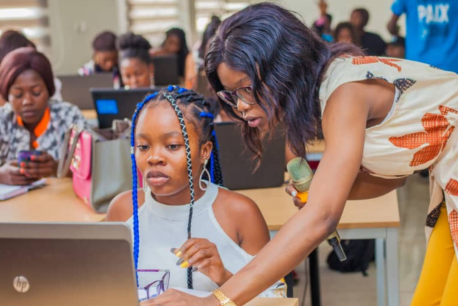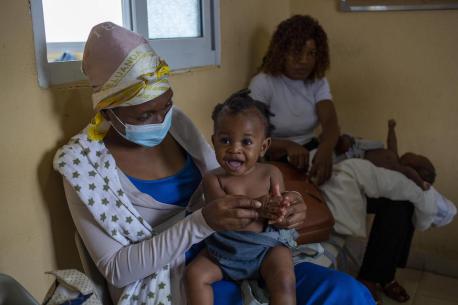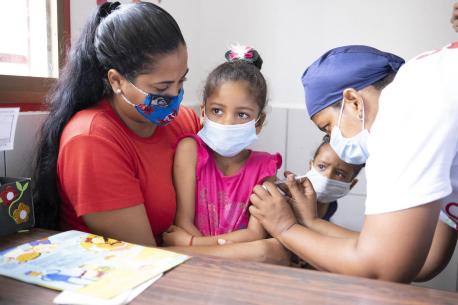
Generation COVID: Coming of Age, Paused
More than any crisis of the past decades, the COVID-19 pandemic has redefined childhood on a global scale. While the struggles of children and young people are undeniable, so is their resilience and desire to participate in rebuilding a better future.
For 18-year-old Julissa, coming of age in Brooklyn, New York during the pandemic signaled a loss of her rites of passage into adulthood. Schools were closed, which meant she didn’t see friends, attend senior prom or have a traditional graduation ceremony. Her excitement at finishing school and going to college was diminished.

One week into New York City’s lockdown, Julissa’s mother, Elaine, and her father, Carlton, fell ill with COVID-19. For Julissa, fear became entwined with daily life. She has spent most of the pandemic in her bedroom, above.

Carlton contracted the virus first. Initially, it seemed no worse than the regular flu. But then Elaine fell ill with chills and weakness, and found herself bedridden for days. On the 14th day of her illness, Elaine went to her window to see an ambulance taking her next-door neighbor away, dead from COVID-19.
The virus, up close and personal, brought a deep and unknown fear into the family’s home and community. “I was afraid to go outside for months,” Elaine says.

Heavy with the emotional trauma of watching her parents fall ill and worried they would contract the virus again, Julissa, above left, frequently shut herself in her room, lights off, sitting on the floor, teeming with anxiety. “I’m not used to seeing my parents like that … That was really hard for me,” she says. “At the deepest point, I just felt like, [my depression] was going to last forever.”

Julissa started going to a therapist to discuss the emotional and mental toll the pandemic was taking on her. “I was stressing about everything. I felt the physical toll it was taking on my body. I was dealing with COVID-19, I was dealing with racism, I was dealing with going off to college and starting the beginning of my adulthood and being on my own for a little bit,” Julissa says.
“As a young person, and someone [who] graduated that year, it almost felt like nobody cared about what I was going through.”

Julissa left for college in August 2020, but quickly returned to Brooklyn when classes went fully online. Elaine’s hair styling business has suffered during the pandemic, and government support has not yet arrived. Some of her employees cannot come to work during the week because they have children at home. Elaine has put out advertisements for jobs at the salon, but she cannot get anyone to work.
Julissa offered to change schools to lessen the financial burden on her parents, but they insisted she attend her top school regardless of finances. "We're trying to get through the financial toll that [the pandemic] took on us," says Elaine.
Julissa says she has become better at processing her anxiety and communicating her emotions through seeing a counselor. “One good thing that came out of [the pandemic] was that the world literally stopped. I'm forced to deal with my anxiety and depression head on and learn things about myself,” Julissa says. "Even though it definitely took a negative toll on me and my family and everybody around us, I was still able to grow."
The COVID-19 pandemic has had a catastrophic impact on the lives of children and young people. Across the globe, too many children remain in limbo, eager to move forward with their dreams but with little control over their present realities. Children must be at the heart of our global response to COVID-19, ensuring that the most marginalized and vulnerable thrive.
This story was produced in collaboration and partnership with the Arthur Ashe Institute for Urban Health. The Institute connects vulnerable communities across Brooklyn, New York to the information, tools and resources they need to make informed health decisions and trains parents, caregivers and youth to support the emotional well-being of children and build resiliency. UNICEF and UNICEF USA thank the Institute for their partnership, and Julissa and Elaine for trusting us with their stories.
Top photo: A narrow driveway connects the back of 18-year-old Julissa's family home in Brooklyn, New York to the street. After Julissa's mother, Elaine, became ill with COVID-19 in the early days of the pandemic, she was afraid to go outside for months. "I didn't even go out on my back step, because I'm thinking it's going to kill all of us," Elaine said. "We can't go outside. I have to stay inside." All photos © Peter Van Agtmael for Magnum Photos
HOW TO HELP
There are many ways to make a difference
War, famine, poverty, natural disasters — threats to the world's children keep coming. But UNICEF won't stop working to keep children healthy and safe.
UNICEF works in over 190 countries and territories — more places than any other children's organization. UNICEF has the world's largest humanitarian warehouse and, when disaster strikes, can get supplies almost anywhere within 72 hours. Constantly innovating, always advocating for a better world for children, UNICEF works to ensure that every child can grow up healthy, educated, protected and respected.
Would you like to help give all children the opportunity to reach their full potential? There are many ways to get involved.





